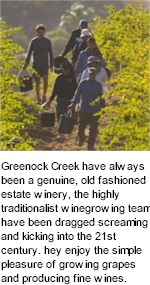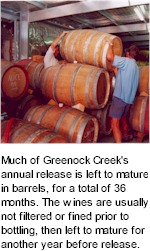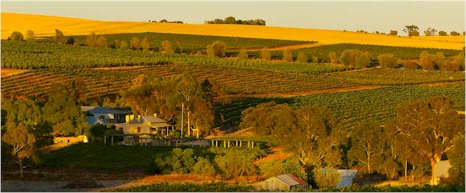


Greenock Creek have always been a genuine estate winery, the highly traditionalist winegrowing team have been dragged screaming and kicking into the 21st century. People who are familiar with them, know that they enjoy the simple pleasure of growing grapes and producing fine wines. They consider themselves to be stubbborn old dogs who still believe in a lot of core values, basic principles like trust and honesty, integrity and hard work, laughter, family and friends. The estate was launched in 1988 with two wines, 1986 Creek Block Shiraz and 1988 Chardonnay. Life was simple back then, it meant working long days which were physically tiring, but immensely rewarding. Tight cash flow, curculio beetles and salvation jane were all part and parcel of accepting life on the land.

Their vineyards are dry grown and the grapes from each patch are kept separate and processed at the small winery. They purchase no fruit, consequently the production can vary considerably from year to year. Their oldest vineyard along Roennfeldt Road at Marananga, 80 years of age, is the smallest of Greenock Creek's precious sites. The vines crop at 1.0 to 1.5 tonnes per acre and grapes are all hand picked, at phenological ripeness and flavour at a baume range of 14� to 16�, a naturally occurring high alcohol, although this will depend on seasonal conditions. Fruit is fermented in large, shallow open fermenters, pumped over, chilled and pressed through a basket press. This tiny vineyard of old vines produces a wine of formidable structure with and intensity of fruit.
Much of Greenock Creek's annual release is left to mature in barrels, all new American hogsheads, for a total of 36 months. The wines are usually not filtered or fined prior to bottling, then left to mature for another 24 months before release. This means that the wine has been in barrel or bottle for in excess of five years prior to being made available.
The Seven Acre vineyard on Radford Road at Seppeltsfield, just south of Greenock, was planted in 1990. As the name suggests, it is approximately 7 acres in size. The vines crop at 1.5 to 2.0 tonnes per acre and grapes are fermented in large, shallow open masonary fermenters, followed by 27 months maturation, unfiltered and unfined prior to bottling.

Greenock's Apricot Block was planted in 1995, on an old apricot orchard which was excised from Roennfeldt Road property. Vines are cropped at 1.2 to 1.5 tonnes per acres from the short rows, and 1.5 to 2.0 tonnes per acre on the long rows. The grapes are picked and kept separate to produce a single estate wine. Parcels of Cabernet Sauvignon, establsihed 1989, grow right outside the Greenock cellar door on Radford Road. Aged in exclusively in French oak, shaved out seasoned second hand hogsheads. The fruit of these mighty vines makes a fragrantly mint and lavender, chocolate and berries perfumed Cabernet Sauvignon, a profoundly varietal wine. The Alice is Greenock's largest vineyard, at 15 acres, named after two favourite aunties, both of whom were named Alice. Established 1997, the grapes are kept separate to produce a single estate wine, showing great depth of flavour, an abundance of fruit, currants, raspberry and juniper, wrapped in a mild oaky finish.
The terrain of Greenock Creek's vineyards can be challenging and harsh, but the fruit produces wines of remarkable depth and quality. The estate flagships are monsters, made from the fruit of gnarled and grizzled, century old vines. They speak for themselves, complex and intense, with masses of berry fruit and spice flavours that are complemented with a lovely oak finish which lingers on and on. Greenock Creek are not just about growing the finest fruit and making great wine, they are always focused on maintaining good old fashioned principles of hard work and honest reward, preserving the sanctity of an ancient lifestyle and respecting the endowments of the land.
